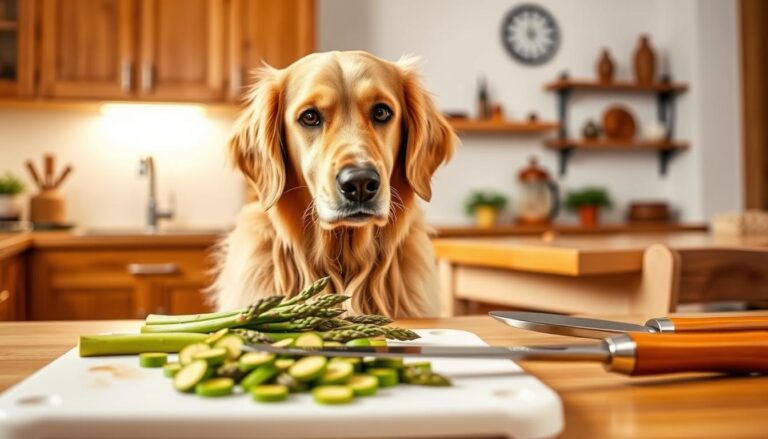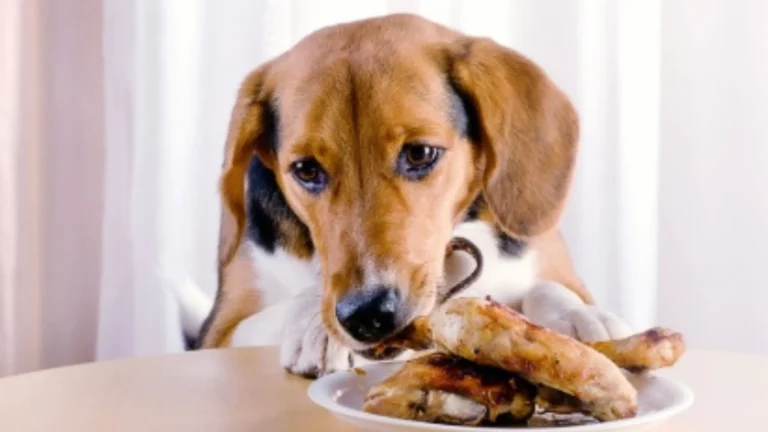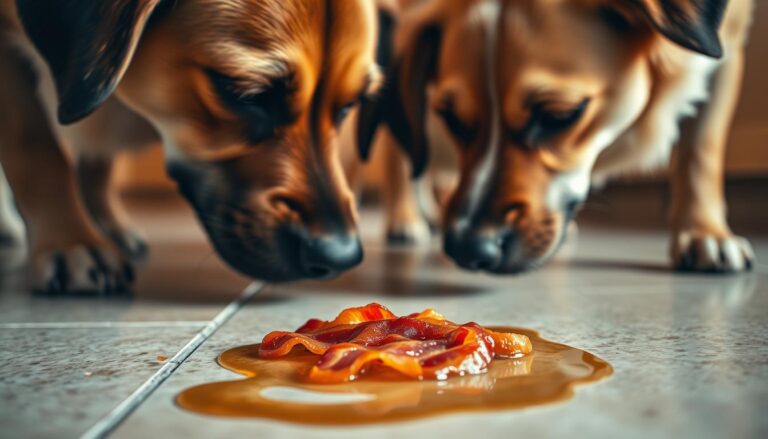Can Dogs Have Raw Chicken Bones? Vet Advice Explained
I remember the first time I wondered what treats were best for my dog. Raw chicken bones were a topic of endless debate. I was unsure if they were safe for my furry friend.
Vets have different views on whether dogs can have raw chicken bones. They say raw bones are different from cooked ones. They offer both benefits and risks for dogs.
It’s important to think carefully about raw chicken bones for dogs. Some owners give raw bones to their dogs, but vets offer advice. They help decide what’s best for your dog’s diet.
This guide will cover everything about raw chicken bones for dogs. We’ll look at the good and bad sides. You’ll learn how to make the best choices for your dog’s nutrition.
Your dog’s health is very important. Knowing if raw chicken bones are safe can greatly affect their well-being. Let’s explore the expert views and science behind this topic.
Table of Contents
Understanding Raw Chicken Bones vs Cooked Bones for Dogs
It’s important to know the difference between raw and cooked bones for dogs. Not all bones are safe for your furry friend. The way bones are prepared matters a lot.
Bone Structure Variations
Raw chicken bones are different from cooked ones. Are raw chicken bones safe for dogs? Yes, they are because of their natural makeup:
- Raw bones stay soft and flexible
- They have more moisture and nutrients
- They are easier to digest
Dangers of Cooked Bones
Cooked chicken bones can be dangerous for dogs. Heat changes their structure, making them:
- Brittle and likely to splinter
- Rigid and sharp
- More likely to cause internal injuries
Natural Benefits of Raw Bones
Raw chicken bones have many benefits for dogs, including:
- Dental health improvement
- Natural teeth cleaning
- Mental stimulation from chewing
- Nutritional benefits
Veterinary experts recommend careful supervision when introducing raw bones to your dog’s diet.
Knowing these differences helps pet owners make better choices. It ensures their dog’s safety and gets the nutrients they need.
The Safety of Raw Chicken Bones for Dogs
When it comes to raw bones for dogs, safety is key. Chicken bones can be a great treat if you’re careful. Not all bones are safe, so choosing the right ones is crucial.
Here are some important safety tips for raw chicken bones:
- Size matters: Choose bones that fit your dog’s breed and size
- Supervise feeding at all times
- Select fresh, high-quality raw bones from trusted sources
- Watch for potential choking hazards
Raw bones have many benefits for dogs, but there are risks too. Bacterial contamination is a big worry. Proper handling and sourcing are critical to minimize these risks. Always buy raw chicken bones from reputable butchers or pet food suppliers who follow strict hygiene standards.
“The key to safely feeding raw chicken bones is informed preparation and constant vigilance.” – Veterinary Nutrition Experts
Dogs react differently to raw bones. Some might have sensitive stomachs or health issues that make bones bad for them. Always talk to your vet before adding raw bones to your dog’s diet.
- Check your dog’s individual health status
- Start with small portions
- Monitor your dog’s reaction
- Stop feeding if any adverse reactions occur
Knowing how to approach raw bones for dogs helps you give them a safe, healthy treat. This can support their overall health and well-being.
Nutritional Benefits of Raw Chicken Bones
Raw chicken bones are great for your dog’s health. They are full of nutrients that help your dog stay healthy and happy.
Raw chicken bones are more than treats. They are a source of important minerals and nutrients that can boost your dog’s diet.
Essential Minerals and Vitamins
Raw chicken bones have key nutrients for your dog’s health:
- Calcium for strong bones and teeth
- Phosphorus for cellular function
- Trace minerals like magnesium and zinc
Joint Health Support Components
The bones have glucosamine and chondroitin. These help keep your dog’s joints healthy. They:
- Reduce inflammation
- Support cartilage repair
- Improve mobility
Dental Health Advantages
Chewing raw chicken bones cleans your dog’s teeth naturally. It:
- Removes plaque buildup
- Stimulates gum health
- Reduces tartar formation
Adding raw chicken bones to your dog’s diet is a smart choice. It’s a healthy and fun way to improve their regular food.
Can Dogs Have Raw Chicken Bones as Part of Their Diet?
Adding raw chicken bones to your dog’s diet needs careful thought. Raw dog food with bones can be good, but it’s important to do it right. You must know how to add them safely and effectively.
Veterinary nutritionists say to balance things out. Raw bones should be a part of a complete diet, not all of it. They bring many benefits:
- Natural dental cleaning
- Nutrient-rich supplementation
- Mental stimulation
- Improved digestive health
Your dog’s needs are key in deciding about bones. Things like age, size, and health matter. They help figure out if raw chicken bones are right for them.
| Dog Size | Recommended Bone Frequency | Portion Guidelines |
|---|---|---|
| Small Breeds | 1-2 times weekly | Smaller, softer bones |
| Medium Breeds | 2-3 times weekly | Moderate-sized bones |
| Large Breeds | 3-4 times weekly | Larger, meatier bones |
Always watch your dog when they eat bones. Talk to your vet to make a plan that fits your dog’s needs.
Different Types of Raw Chicken Bones for Dogs
Choosing the right raw chicken bones for your dog is important. Not all bones are the same. Each type has its own benefits for your dog’s health.
Raw chicken bones can be very good for your dog. But, you need to pick the right one. This depends on your dog’s size, age, and how they chew.
Chicken Wings and Necks: Perfect for Smaller Dogs
Chicken wings and necks are great for small dogs. They are soft and easy to chew. This is perfect for dogs with weaker jaws.
- Excellent source of calcium
- Soft texture for easier digestion
- Good option for puppies and small breeds
Chicken Backs and Carcasses: Ideal for Larger Breeds
Chicken backs and carcasses are best for big dogs. They have more bone and protein. They also offer a strong chewing experience.
- More substantial bone content
- Higher protein concentration
- Robust chewing experience
Chicken Feet and Drumsticks: Nutritional Powerhouses
Chicken feet and drumsticks are full of nutrients. They have lots of glucosamine. This helps support your dog’s joints.
- High glucosamine levels
- Natural joint health support
- Rich in connective tissue nutrients
| Bone Type | Best For | Key Nutritional Benefits |
|---|---|---|
| Chicken Wings | Small Dogs | Calcium, Soft Texture |
| Chicken Necks | Puppies | Easy Digestion, Protein |
| Chicken Backs | Large Dogs | High Protein, Substantial Chew |
| Chicken Feet | All Sizes | Glucosamine, Joint Support |
| Chicken Drumsticks | Medium to Large Dogs | Connective Tissue Nutrients |
Always watch your dog when they eat raw chicken bones. Talk to your vet to make sure these bones are right for your dog.
Potential Risks and Safety Precautions
Thinking about giving your dog raw chicken bones? It’s important to know the risks. Raw bones can be good for your dog, but they also have dangers. Every pet owner needs to think about these risks carefully.
The main dangers of raw chicken bones are:
- Choking hazard: Bones can get stuck in your dog’s throat
- They might cause an intestinal blockage or hole
- Raw meat can have harmful bacteria
- Sharp bone pieces can hurt your dog’s teeth
To make sure raw chicken bones are safe for your dog, follow some key steps. Always watch your dog when they eat bones. Choose bones that fit your dog’s size and breed.
Important safety steps are:
- Buy bones from trusted places
- Check bones for sharp edges
- Watch your dog while they eat
- Take the bone away if it starts to break
- Keep raw bones in sealed containers
Vets say to be very careful with raw chicken bones. If your dog shows signs of trouble, like vomiting or trouble going to the bathroom, call your vet right away.
Remember: Prevention and careful watching are key to safely feeding raw bones to your dog.
How to Properly Feed Raw Chicken Bones to Dogs
Adding raw chicken bones to your dog’s diet needs careful planning. It can be a great way to add nutrition when done right. Here are the key steps to safely feed raw chicken bones to your dog.
Preparation Guidelines
Getting ready is key when adding raw chicken bones to your dog’s diet. Follow these important steps:
- Always get fresh, high-quality raw chicken bones from trusted suppliers
- Rinse bones well under cold water before giving them to your dog
- Check bones for sharp edges or dangers
- Pick bones that fit your dog’s size and chewing style
Feeding Frequency and Portions
The right amount of raw chicken bones depends on several things:
- Dog’s size: Smaller dogs need fewer bones than bigger ones
- Age and health
- What they eat now and what they need
- How they chew
Vets say to start with small amounts, about 10-15% of their diet. Start with one or two bones a week and watch how they do.
Storage and Handling
Storing raw chicken bones safely is very important to stop bacteria from growing:
- Keep bones cold at 40°F or below
- Use them within 2-3 days of buying
- Store in sealed containers
- Never let raw bones sit at room temperature for too long
By following these tips, you can safely add raw chicken bones to your dog’s diet. This can give them important nutrients and help their health.
Signs of Chicken Bone Intolerance or Complications
When dogs eat raw chicken bones, owners need to watch for health risks. Look out for warning signs that mean your dog needs help right away.
Here are key symptoms to watch for after your dog eats chicken bones:
- Digestive Distress: Persistent vomiting or diarrhea
- Visible abdominal pain or discomfort
- Sudden lethargy or weakness
- Difficulty passing stool or constipation
- Excessive drooling or loss of appetite
Dogs eating raw chicken bones can face unexpected problems. Look out for these serious signs that need vet care fast:
- Blood in stool or vomit
- Repeated gagging or choking sounds
- Significant changes in behavior
- Apparent internal discomfort
Every dog reacts differently to chicken bones. Some might be fine, while others could face serious issues. Always keep an eye on your pet after they eat bones and listen to your gut if something seems off.
Veterinary professionals recommend immediate medical evaluation if you notice persistent or severe symptoms after bone consumption.
Preventing problems is the best way to handle chicken bone risks. Talk to your vet for advice that fits your dog’s health and diet needs.
Alternative Natural Bone Options for Dogs
Looking for raw bones for dogs? There are many healthy choices besides chicken bones. Each one has its own benefits for your dog’s health and fun chewing.
Raw beef marrow bones are a top pick. They’re packed with nutrients like calcium and phosphorus. They also help keep your dog’s teeth clean and support their joints and muscles.
Lamb bones are another great choice. They’re softer and easier to digest than beef bones. This makes them perfect for smaller or older dogs.
There are also commercial options for those who want something easy:
- Dental chews made with natural ingredients
- Synthetic bones for safe chewing
- Raw bones dog treats made just for pets
When picking bones for your dog, think about their size, age, and how they chew. Always watch your dog when they’re chewing bones. And talk to your vet to pick the best bones for your dog’s needs.
Conclusion
Deciding if dogs can have raw chicken bones needs careful thought and expert advice. Raw chicken bones can be good for dogs, but they’re not right for every dog. Your dog’s health, age, size, and diet needs are key to making this choice.
Vets say it’s important to weigh the risks before giving raw chicken bones to dogs. You need to do your homework and talk to a vet. Some dogs do well with raw bones, but others might have problems. Always think about your dog’s health when choosing their food.
Being a good pet owner means being careful and informed. If you want to add raw chicken bones to your dog’s diet, do it slowly. Watch how your dog reacts and talk to your vet often. Every dog is different, and what’s good for one might not be for another.
With the right knowledge and vet advice, you can choose the best food for your dog. This helps keep them healthy and happy for a long time.







